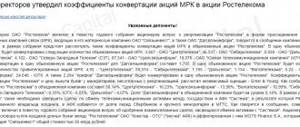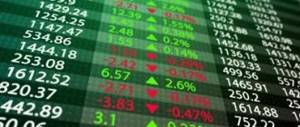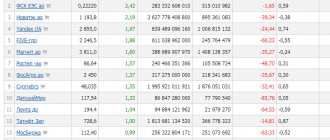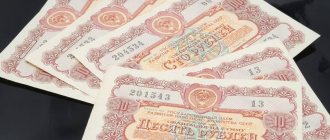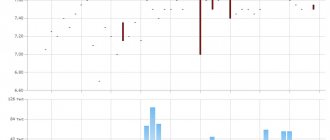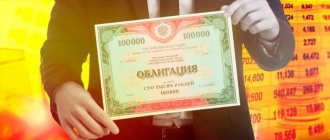Share this useful page:
Bonds are debt securities in which investors are obliged to repay the invested amount with interest after a certain period of time. The market for such assets is an integral part of the developed world economy. It did not bypass the Russian Federation, where there is a developed bond market with its own indicators of the profitability of these securities. Basic knowledge of the mechanisms of this trade can bring significant profits even to beginners.
Historical reference
In Russia, certain debt obligations of subjects and the state were in use even during the Rurik dynasty. And in 1769, the Russian Empress Catherine the Second assumed the first debt obligations on a foreign loan. Official debt securities first appeared in 1809, and by 1881 the volume of government borrowing exceeded 216 billion rubles.
As a result of the October Revolution, the debts of former Russia were cancelled, but a new government loan arose on the domestic market 5 years later. This state financial policy operated intermittently until 1992-94. And then, in connection with the final transition to a market economy, bonds began to be issued not only by state financial institutions, but also by private companies. Corporations and banks became increasingly active players in the debt market. This gave rise to a complex structure of this segment of exchange trading, the basics of which will be discussed below.
How risky is it to buy them?
When purchasing high-yield bonds, an investor does face increased risk. This is practically an axiom in the market.
The more high-yielding the bonds, the greater the scale of problems the issuer experiences.
A discount may also be given for the size of the business and the presence of a credit history.
Small companies that have not yet established themselves are considered less reliable than industry mastodons. Therefore, before buying high-yield bonds, it is worth understanding the financial background of the issuer in order to understand what the reason for the premium to the average market yield lies.
How much can you earn
In theory, you can make a lot of money from high-yield bonds. Especially if you buy specific bonds that have fallen in price, which can recover in value. But this approach only works well in theory.
In practice, there is no point in investing in one or two high-yield securities, since the risk of losing capital is high. Therefore, investors use the principle of diversification and create portfolios from a large number of such bonds. The profitability of these portfolios with a commensurate risk can reach 20-30% per annum on average.
However, there are pitfalls here, which I will discuss further.
Is it profitable to buy
In fact, when compared with other instruments, high-yield coupon bonds of Russian issuers are not profitable to buy. This is due to the fact that bonds issued after January 1, 2021 are exempt from coupon income tax of 13%.
But profits on bonds whose yield is 5% higher than the key rate are now taxed at 35% of the amount of profit exceeding this amount.
Expert opinion
Vladimir Silchenko
Private investor, entrepreneur and blog author
Ask a Question
Active bond trading also incurs costs in the form of commission fees. For each transaction with ordinary bonds, the broker will charge about 0.05%, and for Eurobonds commissions can reach up to 0.3-0.4% of the turnover.
Debt securities in the Russian Federation today
Today, about 2,000 issues of various bonds are available for purchase on the Russian market. Therefore, the investor has plenty to choose from. All bonds are traded on the Moscow Exchange.
For investors
If you already have a brokerage account and are looking for which market they trade on, then you need to transfer funds to the “Main Market”.
Bonds in the Russian Federation are divided into 4 main types:
- Federal loan bonds (OFZ) are government bonds issued by the Ministry of Finance of the Russian Federation (Ministry of Finance), and the regulator is the Central Bank of Russia (CBRF).
- Municipal bonds are regional bonds issued by constituent entities of the Russian Federation. They are issued by almost all entities and are considered reliable securities. For example, the Moscow region issues its bonds with a good yield: Moscow Region-34011-ob (7.5% coupon) and Moscow Region-35010-ob (9.65% coupon).
- Corporate - many Russian companies also issue debt securities. The interest on them varies and depends on the reliability of the enterprise and whether it is able to pay its debts. Large companies have a relatively risk-free interest rate on these bonds for investors: 8 - 15%.
- Eurobonds are foreign currency bonds that are issued to the world market. The issuer of these securities can be the state, a company, or a municipality.
In addition, there are also foreign bonds. Foreign issuers are states or foreign corporations that take interest-bearing loans from other countries to stimulate their own development. A well-known example is US bonds, but buying them on the Russian market is not so easy.
June 2020
Artyom Kalinin, CFA
Asset Manager
Important for May:
- Weak performance of US High Yield bonds.
- Bond markets have gone through an entire credit cycle in record time, from widening spreads to placements by the weakest issuers.
- US Treasury yields remain low despite a clear economic recovery.
- The potential for narrowing spreads in investment grade bonds has been exhausted; the upside in High Yield still remains.
- It is wise to maintain a high allocation to risky assets, but be careful and lock in securities that do not have the potential to narrow spreads.
In June, the dynamics of bond market segments diverged. High Yield U.S. bonds posted slight losses, while investment grade and emerging market bonds rose:
- US company bonds investment grade (LQD): + 2.1%
- US company bonds with speculative rating High Yield (HYG): -0.2%
- Emerging Market Bonds (EMB): +3.4%
The underperformance of US High Yield bonds began in mid-June and was caused by a number of factors:
- Problem #1: The pace of US economic recovery.
On June 10, Fed Chairman Powell gave a forecast for the US economic recovery, in which he confirmed that growth will be slow, and full economic recovery will take several years and will directly depend on the speed of development of a vaccine against the virus. At the same time, the head of the Fed promised to continue to do “everything possible” to support the economy, although he refrained from immediately announcing new incentives. Stock markets reacted sharply to this news, which was quite unexpected, since most experts have repeatedly expressed the opinion that it is impossible to fully restore the economy until a vaccine is invented. We believe that the fall in markets following Powell's statements can be interpreted as profit-taking after the strong growth of markets from early May to mid-June.
- Problem No. 2: increase in COVID-19 diseases.
In the second half of June, recorded cases of COVID-19 began to increase again. The increase in infections has become widespread on a global scale and has coincided with the easing of lockdown regimes. It is obvious that the authorities of countries around the world will again be faced with a choice: tighten quarantine measures, sacrificing the economy, or leave everything as it is, maintaining hope for a restoration of economic growth. So far, the position of politicians is leaning towards easing quarantine regimes, despite the increase in diseases. In particular, US authorities believe that the increase in detected cases is caused by improved testing, and not by a real increase in new diseases.
- Problem No. 3: the complication of the political situation in the United States.
The election race in the United States is in full swing and has already brought surprises: Democratic candidate Biden has sharply taken the lead and now his chances of winning, according to various estimates, are estimated at 50-60%, while Trump’s are at 30-40%. Just a few months ago, most experts were confident of Trump's victory, but the development of the Black Lives Matter movement creates serious obstacles to his victory.
It is important to understand that the intensification of problems with coronavirus and politics in the United States does not mean that the markets will face an imminent correction. For example, there may be positive news about a vaccine. Or the Trump government, as a pre-election measure, will begin to actively spend the $1.5 trillion of liquidity accumulated in Treasury accounts. Against the backdrop of endless support from the Fed, all these factors could push risk assets to new highs.
It is noteworthy that since the end of February the bond market has gone through almost a full life cycle: from the first sale and widening of spreads to the return of the weakest issuers to the primary market. Over the past three months we have seen:
- Sharp rise and then narrowing of spreads in the highest quality Investment Grade bonds. Spreads on bonds of many US issuers are already close to early 2021 levels. Upside remains mostly in cyclicals (such as commodities) or sectors directly affected by the virus (such as tourism).
- Record volume of bond placements. Moreover, if in April-May placements were predominantly from the highest quality companies (for example, $8.5 billion in new bonds from Apple or $10 billion in placements from Amazon), then in June weaker companies also entered the market (one can note companies with ratings B/CCC - Scientific Games, Century Aluminum, Acadia Healthcare - and weak countries like Belarus). Some issuers (Ford, AerCap) have returned to the primary market.
- Decrease in profitability of initial placements. If in April-May most new issues offered very interesting coupon rates, then by June many issuers, taking advantage of high investor demand, began to greatly underestimate the yield offered during the placement. One can note, for example, the placement of 7-year dollar bonds of Alrosa: the primary yield indicator was at the level of 3.375-3.5%, but in the end the placement took place at 3.1%. The company's business is currently in a difficult state, but this did not prevent the placement from being successful.
Based on the above facts, it can be considered that bond markets are now in a relatively normal, stable state, with no obvious inefficiencies.
US Treasury yields remain at persistently low levels:
Theoretically, the yield on long-term bonds - 10 and 30 year - should rise against the backdrop of an improving situation in the economy, because economic growth is associated with increased inflation expectations. However, in practice we have not yet observed this - spreads between 2-year and long-term bonds have stopped growing over the past 1.5 months:
There are several explanations for why long-term bond yields are not rising:
- Market participants do not believe in the real possibility of a full recovery of the US economy in the near future. Many analysts believe that the United States could repeat the scenario of Europe and Japan, where the economy and inflation have not recovered to the levels of the mid-2000s.
- Even if the economy recovers, the Fed may try to keep rates artificially low in order to finance the US budget deficit at the lowest possible rates.
- Investors remain interested in protective assets (government bonds, gold) amid the risks of the pandemic and the US elections.
We believe that long-term US bond yields will be very volatile over the next six months, both upward (with a radical improvement in the US economy) and downward (with the risks of COVID-19 and the US elections rapidly increasing). Investors should keep a close eye on this asset class.
The potential for narrowing credit spreads in US investment-grade bonds has almost been exhausted. The chart below shows that for Investment Grade bonds of all durations the spread may narrow by no more than 50 bp to the levels of early 2021. Given that the market was overheated at the beginning of the year and spreads were unnaturally narrow, we believe that there is no growth potential left in Investment Grade bonds at all.
On the contrary, bonds rated High Yield have significant potential for further narrowing of spreads - by 200-300 bp to the levels at the beginning of the year:
In the current situation, we believe that it is reasonable for investors to maintain an allocation to the risky segment of the bond market: High Yield and emerging market bonds, as well as individual Investment Grade bonds that retain the potential for narrowing spreads. Current economic statistics for the largest countries (USA and China) look promising, the largest central banks maintain maximum support measures - these factors should support risky assets.
At the same time, we believe that the time for market inefficiency has passed and investors should pay more careful attention to controlling the risks in their portfolios. Many segments of the economy (for example, restaurants, raw materials or tourism) are still very far from recovery. To date, most issuers in these sectors have been able to resolve liquidity problems, but with a slow economic recovery, the credit risk of such issuers will increase again.
Development of interest
The critical point, when demand for bonds fell to a minimum due to the peak of the financial crisis, was passed in 1998. Since then, interest in debt securities in Russia has been constantly growing . According to the Moscow Exchange, which produces monthly trading reports, it can be seen that bond trading volumes are growing every year by 15%-30%.
For example, in April 2021, the increase in the volume of exchange trading in the market for government, regional and corporate bonds amounted to 33.2% (more than 1817.7 billion rubles compared to 1364.2 billion rubles in 2021). During April 2021, the Moscow Exchange placed 58 bonds on the market, the total value of which was 1554.6 billion rubles, of which 994.4 billion rubles. accounted for placed one-day bonds.
It may already be 2021 or 20 by the time you read this, but we wanted to show that this news indicates that the popularity of this type of asset is growing, which continues steadily. You can follow such reports yourself on the moex website in the news section. What we suggest you do is look for “Tender Results”.
Features and nuances of the stock market
The stock market is part of the general financial market, in the vastness of which various securities are traded, including bills, shares, investment shares, etc. It is worth noting that participants in the stock market are a fairly “motley” contingent - investors, brokers, issuers.
Most of the participants in the stock market are brokers (intermediaries) who carry out orders from holders of stock assets to sell existing securities or buy new securities. Investors are represented by people who make various investments. In essence, these are wealthy and not so wealthy citizens who invest their money in securities in the hope that they will make a profit on changes in the exchange rate. Issuers are the companies themselves that issue securities. By issuing and trading securities of their company, the company's management attracts the missing funds into its circulation. It is not for nothing that brokers are called “intermediaries” in this scheme, because they are the ones who help the issuer and the investor find each other.
How to behave in the stock market is a “nothing” question. Which category of participants do you consider yourself to be? What goals are you pursuing? What assets do you have? It is worth noting that there are a huge number of fraudulent and illegal transactions in the stock market. Behavior on the stock market can be different and largely depends on what goals the trading participant is pursuing.
Russian market indicators
Important: buying bonds is far from the riskiest transactions on the securities market, but they do not guarantee one hundred percent success. Both corporations and even states may go bankrupt, which will inevitably reduce the yield of bonds, that is, their profitability for the one who lends money.
To predict the future value of debt securities, various financial indicators - indices - are used. Below are the main ones used on Russian exchanges.
- RUABITR is an indicator reflecting total income. To calculate it, the cost of debt securities is used (price + cash income). Reinvested coupon payments are taken into account.
- RGBITR is calculated on the basis of the most liquid federal loan securities, the duration of which exceeds 12 months. The calculation determines the total income.
- MICEXMBICP and MICEXMBITR are the corresponding indices for municipal bonds.
Where can I see index charts?
You can find out the values of debt securities indices on special websites, for example, tradingview. This is a great tool for analyzing markets and viewing charts and indices. You can build your own charts and conduct technical analysis. To search for these indices, simply enter their codes into the search bar and you will be taken to a page with an interactive chart. We recommend registering.
A very useful video that will tell you what stock indices are, how they work and why they are so useful for investors.
How to make money on high-yield securities
Profit on high-yield bonds, like any other bond, consists of two things:
- The first is receiving regular coupon payments. And if the bond coupon rate is high, then the earnings percentage will be corresponding. Especially when the investor uses the approach of reinvesting interest in bonds.
- The second possibility of high-yield bonds lies in the value of the bond body. Buying for 900 rubles. bond with a par value of 1000 rubles, you can expect that the additional profit upon redemption will be 100 rubles. or 10%.
But, of course, you don’t always have to wait for the bond to mature. Bond quotes are interactive and calculated online, which means that even on fairly long bond issues you can make money by buying and selling bonds on the secondary market.
Russian government debt is at a low level
Russian debt policy has remained quite conservative over recent years, despite the gradual (until 2020) expansion of the volume of both internal and external debt. For several years (2017-2021), the share of external public debt has been maintained at 20-25%.
The debt-to-GDP ratio remains one of the lowest in the world, remaining at 13-14% until 2021. At the same time, the average debt-to-GDP ratio for developed economies in 2021 was 103.8%, and for developing economies – 54.7%.
Table 1. Public debt to GDP ratio in selected developed and developing countries.
| A country | Credit rating (Fitch/Moody's/S&P) | Debt/GDP (5-year average), % | Debt/GDP (2020*), % | Debt/GDP (2021*), % |
| Germany | AAA/Aaa/AAA | 64.9 | 68.9 | 70.3 |
| USA | AAA/Aaa/AA+ | 110.8 | 127.1 | 132.8 |
| China | A+/A1/A+ | 55.5 | 66.8 | 69.6 |
| Saudi Arabia | A/A1/A- | 20.9 | 32.4 | 31.0 |
| Russia | BBB/Baa3/BBB- | 15.2 | 19.3 | 18.1 |
| India | BBB-/Baa3/BBB- | 74.4 | 89.6 | 86.6 |
| Mexico | BBB-/Baa1/BBB | 55.6 | 60.6 | 60.5 |
| Brazil | BB-/Ba2/BB- | 86.8 | 98.9 | 98.4 |
| South Africa | BB-/Ba2/BB- | 60.1 | 77.1 | 80.8 |
Source: IMF, CBonds.
At the same time, Russia has a significant amount of liquid assets - in particular, a significant amount of funds in the National Welfare Fund. At the end of 2021, Russia’s net debt became negative: the liquid assets of the “extended” government exceeded the public debt in the broad sense (internal and external debts of the state, regions, municipalities). In 2021, net debt became positive again - the COVID-19 pandemic required borrowing, however, at the beginning of 2021, net debt remains small.
Widening spreads
You've probably heard of the term widening spreads. What is it about?
In the USA there are various sectors. Some corporate bonds have a high reliability rating, some have a lower rating and, accordingly, a higher yield. This is a segment of risky investments in the debt market - HY -high yield.
When the difference between the yield of HY and reliable securities (Treasuries can be taken as a guide) decreases, this means that investors are willing to buy risk. And everything is more or less calm - after all, we remember that the debt market is more important than the stock market and events will first take place there.
If the difference between the yield of HY and reliable securities increases, then signs of risk off appear. And negative trends will also spread to the Russian debt market, since it is also risky, and even more so than the dollar market.
How does the debt trading market work?
Few people know that not only professional participants in the debt trading market (for example, debt collectors), but also any person can make money from buying debts, if he has free financial resources, a desire to invest in this direction, an understanding of the legal mechanism for the purchase and sale of debts and a sober assessing your risks. Let's talk today about how the debt market works in Russia.
❓What is the buyer's benefit?
Any debt is sold at a discount, the amount of which includes the buyer’s interest (his expected net profit) and the costs that will be required for collection. Moreover, depending on the level of risks, the discount can range from ten to ninety percent of the cost of the debt. It is clear that the higher the discount, the greater the risks and vice versa. Any debt is sold at a discount, the amount of which includes the buyer’s interest (his expected net profit) and the costs that will be required for collection. Moreover, depending on the level of risks, the discount can range from ten to ninety percent of the cost of the debt. It is clear that the higher the discount, the greater the risks and vice versa.
❓How much can you earn?
This is very similar to playing on the stock market. It all depends on the ability to analyze information about debt, realistically calculate your risks and assess the market situation. Some people manage to increase their capital several times over the course of a year by purchasing debt. Some people's profits are quite modest, while others simply lose their money. This is very similar to playing on the stock exchange. It all depends on the ability to analyze information about debt, realistically calculate your risks and assess the market situation. Some people manage to increase their capital several times over the course of a year by purchasing debt. Some people's profits are quite modest, while others simply waste their money.
❓How is the purchase of debt processed?
For the purchase and sale of debt, since the times of Ancient Rome, the legal structure of an assignment agreement has been used, allowing the creditor (assignor) to cede his right of claim against the debtor to a third party - the buyer of the debt (assignee). of the assignment agreement has been used since the times of Ancient Rome.
, allowing the creditor (assignor) to assign its right of claim against the debtor to a third party - the buyer of the debt (assignee).
❓How to buy debts and not make a mistake?
First of all, you need to obtain complete information about the debt, the availability of collateral, liquid assets of the debtor, etc. Then you need to carefully check all the information and carefully read the terms of the agreement for the assignment of claims. Purchasing secured debts brings stable results; it is also most profitable to buy receivables from companies
than consumer loans to individuals. However, the discount on such debts is much smaller.


